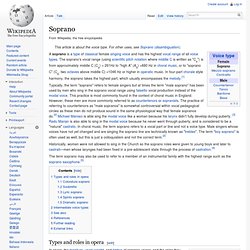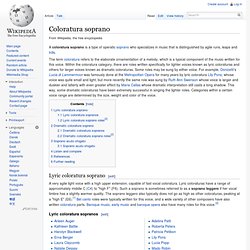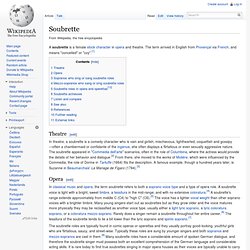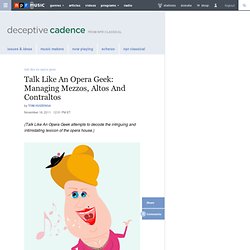

Soprano. A soprano is a type of classical female singing voice and has the highest vocal range of all voice types.

The soprano's vocal range (using scientific pitch notation where middle C is written as "C4") is from approximately middle C (C4) = 261Hz to "high A" (A5) =880 Hz in choral music, or to "soprano C" (C6, two octaves above middle C) =1046 Hz or higher in operatic music. In four-part chorale style harmony, the soprano takes the highest part, which usually encompasses the melody.[1] Talk Like An Opera Geek: Sizing Up Sopranos : Deceptive Cadence. (Talk Like An Opera Geek attempts to decode the intriguing and intimidating lexicon of the opera house.) hide caption From stratospheric coloraturas to jet-powered Wagnerians, learn to love our highest-flying singers. iStock From stratospheric coloraturas to jet-powered Wagnerians, learn to love our highest-flying singers.

Voices are as individual as the people they belong to, yet the opera world has created convenient pigeonholes for categorizing them. You've got your main groupings — sopranos, mezzos, tenors, baritones and basses — but there's more to it than that. Coloratura soprano. The term coloratura refers to the elaborate ornamentation of a melody, which is a typical component of the music written for this voice.

Within the coloratura category, there are roles written specifically for lighter voices known as lyric coloraturas and others for larger voices known as dramatic coloraturas. Some roles may be sung by either voice. For example, Donizetti's Lucia di Lammermoor was famously done at the Metropolitan Opera for many years by lyric coloratura Lily Pons, whose voice was quite small and light, but more recently the same role was sung by Ruth Ann Swenson whose voice is larger and duskier and latterly with even greater effect by Maria Callas whose dramatic interpretation still casts a long shadow.
This way, some dramatic coloraturas have been extremely successful in singing the lighter roles. Die Zauberflöte-Mozart. The Tempest-Ades. Lyric soprano. Light lyric soprano[edit] A light-lyric soprano has a bigger voice than a soubrette but still possesses a youthful quality.[3] There are a wide variety of roles written for this voice, and they may sing soubrette, baroque and other light roles as well.[4][5] Light lyric sopranos[edit]

Dramatic soprano. A dramatic soprano is a type of operatic soprano with a powerful, rich, emotive voice that can sing over, or cut through, a full orchestra.

Thicker vocal folds in dramatic voices usually (but not always) mean less agility than lighter voices but a sustained, fuller sound. Usually this voice has a lower tessitura than other sopranos, and a darker timbre. They are often used for heroic, often long-suffering, tragic women of opera. Spinto soprano. A spinto soprano (also lirico-spinto or "pushed lyric") is a category of operatic soprano voice that has the limpidity and easy high notes of a lyric soprano, yet can be "pushed" on to achieve dramatic climaxes without strain.

This type of voice may possess a somewhat darker timbre, too, than the average lyric soprano. It generally uses squillo to "slice" through the sound of a full orchestra, rather than singing over the orchestra like a true dramatic soprano. The spinto repertoire includes many roles written by Verdi, by the various verismo composers, and by Puccini. Some of these roles are extremely popular with opera audiences. Certain Wagnerian heroines such as Elsa, Elisabeth and Sieglinde are also sung by spinto sopranos. Soubrette. A soubrette is a female stock character in opera and theatre.

The term arrived in English from Provençal via French, and means "conceited" or "coy".[1] Theatre[edit] Mezzo-soprano. A mezzo-soprano or mezzo (English pronunciation: /ˈmɛtsoʊ/, /ˈmɛzoʊ/; Italian: [ˈmɛdzo] meaning "half soprano") is a type of classical female singing voice whose vocal range lies between the soprano and the contralto voice types.

The mezzo-soprano's vocal range usually extends from the A below middle C to the A two octaves above (i.e. A3–A5 in scientific pitch notation, where middle C = C4). Talk Like An Opera Geek: Managing Mezzos, Altos And Contraltos : Deceptive Cadence. (Talk Like An Opera Geek attempts to decode the intriguing and intimidating lexicon of the opera house.) hide captionDon't mix up your mezzos and contraltos. iStock Don't mix up your mezzos and contraltos.

Last week we scaled the heights of the highest vocal range, the soprano. Today, let's take one step down the vocal ladder. Contralto. A contralto is a type of classical female singing voice whose vocal range is the lowest female voice type,[1] with the lowest tessitura.[2][3] The contralto's vocal range falls between tenor and mezzo-soprano; typically between the F below middle C (F3 in scientific pitch notation) to the second F above middle C (F5), although at the extremes some voices can reach the E below middle C (E3) or the second B♭ above middle C (B♭5).[1] Terminology[edit] "Contralto" is meaningful only in reference to classical and operatic singing, as other genres lack a system of vocal categorization comparable to that generally accepted in the classical context.

Even within current operatic practice, contraltos are often classed as mezzo-sopranos, because singers in each range can cover for those in the other. When appearing separately, the term "contralto" applies only to female singers; men whose voices fall in the same range or higher are known as "countertenors. Countertenor. Tenor. A tenor is a type of classical male singing voice whose vocal range is one of the highest of the male voice types. The tenor's vocal range (in choral music) lies between C3, the C one octave below middle C, and (A4), the A above middle C. In solo work, this range extends up to (C5), or "tenor high C". The low extreme for tenors is roughly A♭2 (two A♭s below middle C). At the highest extreme, some tenors can sing up to two Fs above middle C (F5).[1] Within musical theatre, most tenor roles are written between B♭2 and A4, especially the romantic leads, although some fall as low as A♭2 and others as high as F5.
Talk Like An Opera Geek: Tuning Into Tenors : Deceptive Cadence. (Talk Like An Opera Geek attempts to decode the intriguing and intimidating lexicon of the opera house.) hide captionTenors may be characterized as head-strong and unpredictable, but they can produce pretty sounds. iStock In the opera world, when it comes to male singers, the tenor is the big star — think Pavarotti and Domingo. They get to play kings, heroes, swashbuckling lovers and high-maintenance romantics. Baritone. Talk Like An Opera Geek: Breaking Down Baritones : Deceptive Cadence. (Talk Like An Opera Geek attempts to decode the intriguing and intimidating lexicon of the opera house.) hide captionDon't let a bounty of baritones leave you bewildered. iStock Don't let a bounty of baritones leave you bewildered. Bass (voice type)
A bass is a type of classical male singing voice and has the lowest vocal range of all voice types. According to The New Grove Dictionary of Opera, a bass is typically classified as having a vocal range extending from around the second E below middle C to the E above middle C (i.e., E2–E4).[1] Its tessitura, or comfortable range, is normally defined by the outermost lines of the bass clef. Range of bass voices according to the The Oxford Dictionary of Music. Middle C is highlighted in yellow. The low extreme for basses is generally C2 (two Cs below middle C). However, several extreme bass singers, referred to as basso profondos and oktavists, are able to reach much lower than this. In choral music, voices are subdivided into first bass and second bass, no distinction being made between bass and baritone voices, in contrast to the three-fold (tenor–baritone–bass) categorization of solo voices. Basso cantante means "singing bass".[3] Basso cantante is a higher, more lyrical voice.
Talk Like An Opera Geek: In the Basement With The Basses : Deceptive Cadence. (Talk Like An Opera Geek attempts to decode the intriguing and intimidating lexicon of the opera house.) hide captionSeismic singing from the bottommost voices: Know your basso buffo from your basso profondo. iStock Seismic singing from the bottommost voices: Know your basso buffo from your basso profondo.
We've been descending though the vocal ranges over the past few weeks, from soprano and mezzo down to tenor and baritone. Fach. The German Fach (pl. Fächer, literally "compartment" or also "subject (of study)", here in the sense of "(vocal) specialization") (German pronunciation: [ˈfax, ˈfɛçɐ]) system is a method of classifying singers, primarily opera singers, according to the range, weight, and color of their voices.
It is used worldwide, but primarily in Europe, especially in German-speaking countries and by repertory opera houses.